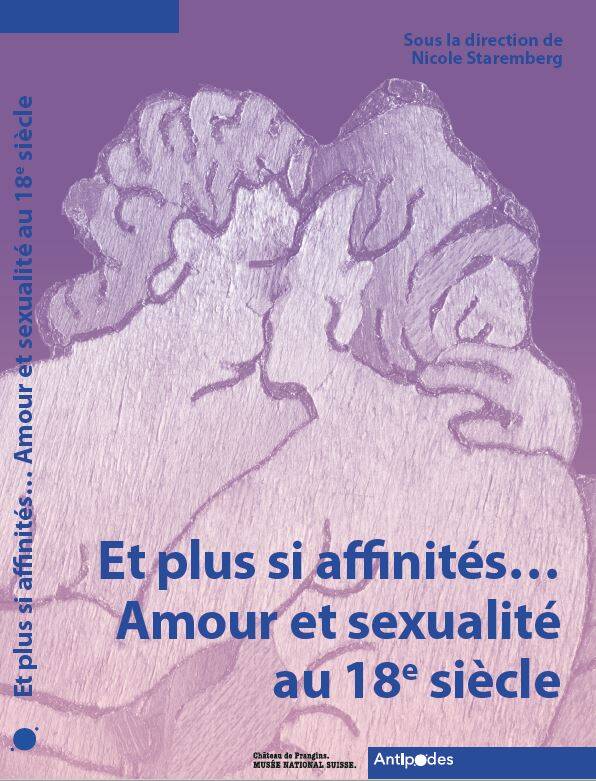accessibility.sr-only.body-term
A Matter of Affinity, the new exhibition at Château de Prangins – Swiss National Museum, explores issues of love and sexuality in the 18th century.
Today sexuality, either overt or implied, is omnipresent in the endless flow of images transported by the media and the entertainment business. “Sex sells!” the marketing specialists all tell us. And yet: hasn’t sexuality always been about dreams and fantasies? Above and beyond the act of procreation, it is now – fortunately – accepted in the West that the pursuit of pleasure should be founded on mutual consent and full awareness. But how did things look back in the 18th century? Where were the barriers of censorship, and where was the dividing line between acceptable and punishable? Were people able to choose their partner, or partners? A Matter of Affinity offers some occasionally surprising (but invariably documented) answers to these questions.
The exhibition highlights the aspiration to greater freedom and the pursuit of hedonistic pleasure, and sets them against affirmations of the importance of marital love, the child and the family. At the interface of the public and private spheres, it traces a progression from first meeting through to childbirth, examining the controls on sexuality put in place by the authorities but also the “gallant” and erotic imaginaries, contraceptive practices and the gendered body. These issues are brought to life by everyday objects, some of them valuable and rare, and previously unseen documents.
The exhibition also hears from some 18th-century “experts” on seduction, desire and sexuality. They include Casanova, who travels through Switzerland in 1760 engaging in numerous sexual encounters along the way, and the famous physician Samuel Auguste Tissot from Lausanne, author of the equally famous book Onanism, which condemns the practice of masturbation.
Exhibition curator: Nicole Staremberg
Venez passer des moments passionnants, ludiques, inspirants, instructifs ou amusants au Château de Prangins! Une large panoplie d'activités, spécialement imaginées et conçues pour différents types de publics et de groupes, vous est proposée.
Une équipe expérimentée et enthousiaste vous attend.
Des visites guidées privées sont possibles pendant ainsi qu'en dehors des heures d'ouverture.
|
Inscription |
deux semaines à l’avance |
|
|
Durée |
60 minutes, autres offres sur demande |
|
|
Participants |
25 personnes au max. |
|
| Langues |
Allemand, français, italien et anglais. Autres sur demande. |
|
|
Coûts |
CHF 120 pour la visite guidée, plus l’entrée à tarif réduit de CHF 10 par personne. Entrée libre pour les enfants et les jeunes jusqu’à 16 ans. |
Et plus si affinités... Amour et sexualité au 18e siècle
180 pages
In French
Editions Antipodes, 2020
ISBN 978-2-88901-178-0
CHF 29.-
This book is sold at the museum shop, at bookshops or can be ordered info.prangins@museenational.ch or +41 (0)22 994 88 90

A Matter of Affinity – Love and Sexuality in the 18th Century
A Matter of Affinity, the new exhibition at Château de Prangins – Swiss National Museum, explores issues of love and sexuality in the 18th century.
Today sexuality, either overt or implied, is omnipresent in the endless flow of images transported by the media and the entertainment business. “Sex sells!” the marketing specialists all tell us. And yet: hasn’t sexuality always been about dreams and fantasies? Above and beyond the act of procreation, it is now – fortunately – accepted in the West that the pursuit of pleasure should be founded on mutual consent and full awareness. But how did things look back in the 18th century? Where were the barriers of censorship, and where was the dividing line between acceptable and punishable? Were people able to choose their partner, or partners? A Matter of Affinity offers some occasionally surprising (but invariably documented) answers to these questions.
The exhibition highlights the aspiration to greater freedom and the pursuit of hedonistic pleasure, and sets them against affirmations of the importance of marital love, the child and the family. At the interface of the public and private spheres, it traces a progression from first meeting through to childbirth, examining the controls on sexuality put in place by the authorities but also the “gallant” and erotic imaginaries, contraceptive practices and the gendered body. These issues are brought to life by everyday objects, some of them valuable and rare, and previously unseen documents.
The exhibition also hears from some 18th-century “experts” on seduction, desire and sexuality. They include Casanova, who travels through Switzerland in 1760 engaging in numerous sexual encounters along the way, and the famous physician Samuel Auguste Tissot from Lausanne, author of the equally famous book Onanism, which condemns the practice of masturbation.
Exhibition curator: Nicole Staremberg
Documents
Images
Tatiana Oberson
Head of Marketing, Communication & Fundraising

